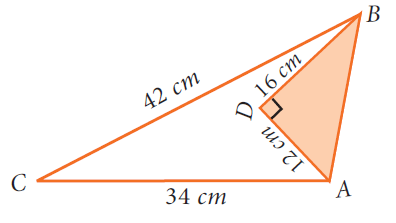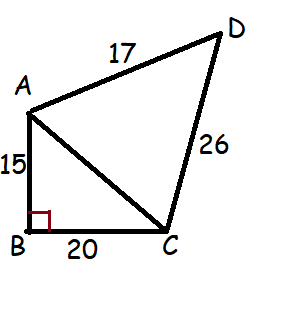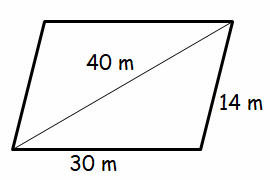FINDING AREA OF QUADRILATERAL PARALLELOGRAM AND RHOMBUS WORD PROBLEMS
Subscribe to our ▶️ YouTube channel 🔴 for the latest videos, updates, and tips.
Problem 1 :
Find the area of the unshaded region.

Solution :
<BDA = 90
AB2 = DA2 + DB2
AB2 = 122 + 162
AB2 = 144 + 256
AB2 = 400
AB = 20
Area of unshaded region = Area of ACB - Area of ADB
Area of ACB :
AC = 34 cm, BC = 42 cm and AB = 20
s = (a + b + c)/2
s = (34 + 42 + 20)/2
s = 48
s - a = 48 - 34 = 14, s - b = 48 - 42 = 6
and s - c = 48 - 20 = 28
= √s(s - a) (s - b) (s - c)
= √48 ⋅ 14 ⋅ 6 ⋅ 28
= 336 cm2
Area of ADB :
DB = 16 cm, DA = 12 cm and AB = 20
s = (16 + 12 + 20)/2
s = 48/2 = 24
s - a = 24 - 16 = 8, s - b = 24 - 12 = 12
and s - c = 24 - 20 = 4
= √24 ⋅ 8 ⋅ 12 ⋅ 4
= 96 cm2
Area of unshaded region = 336 - 96
= 240 cm2
Problem 2 :
Find the area of a quadrilateral ABCD whose sides are AB = 13cm, BC = 12cm, CD = 9cm, AD = 14cm and diagonal BD = 15cm.
Solution :

Area of quadrilateral ABCD = Area of ADB+Area of DBC
Area of ADB :
a = 13, b = 15, c = 14
s = (13 + 15 + 14)/2 = 21
= √21(21 - 13) (21 - 15) (21 - 14)
= √21 ⋅ 8 ⋅ 6 ⋅ 7
= 84 cm2
Area of BDC :
a = 12, b = 9, c = 15
s = (12 + 9 + 15)/2 = 18
= √18(18 - 12) (18 - 9) (18 - 15)
= √18 ⋅ 6 ⋅ 9 ⋅ 3
= 54 cm2
Area of quadrilateral = 84 + 54
= 138 cm2
Problem 3 :
A park is in the shape of a quadrilateral. The sides of the park are 15 m, 20 m, 26 m and 17 m and the angle between the first two sides is a right angle. Find the area of the park.
Solution :

In triangle ABC,
AC2 = AB2 + BC2
AC2 = 152 + 202
AC2 = 225 + 400
AC = √625 = 25
Area of quadrilateral ABCD = Area of ABC+Area of ADC
Area of ABC :
a = 15, b = 20, c = 25
s = (15 + 20 + 25)/2 = 30
= √30(30 - 15) (30 - 20) (30 - 25)
= √30 ⋅ 15 ⋅ 10 ⋅ 5
= 150 cm2
Area of ADC :
a = 17, b = 26, c = 25
s = (17 + 26 + 25)/2 = 34
= √34(34 - 17) (34 - 26) (34 - 25)
= √34 ⋅ 17 ⋅ 8 ⋅ 9
= 204 cm2
Area of quadrilateral = 150 + 204
= 354 cm2
Problem 4 :
The front of an A-frame house is in the shape of a triangle. The height of the house is 20 feet. The area of the front of the A-frame is 600 square feet. Write and solve an equation to find the base of the A-frame house.
Solution :
Area of the frame in the shape of triangle
= 600 square feet
(1/2) x base x height = 600
height = 20 ft
(1/2) x base x 20 = 600
base x 10 = 600
base = 600/10
base = 10 ft
So, the required base of the triangle is 10 ft.
Problem 5 :
One side of a parallelogram is 18 cm and its distance from the opposite side is 8 cm. The area of the parallelogram
Solution :
Base = 18 cm
Height = 8 cm
Area of parallelogram = base x height
= 18 x 8
= 144 cm2
Problem 6 :
A parallelogram has sides 30 m and 14 m and one of its diagonals is 40 m long. then the area is :
Solution :
In parallelogram, opposite sides will be equal. The triangle created by the sides of the parallelogram and diagonal.

a = 30, b = 14, c = 40
s = (30 + 14 + 40)/2 = 42
Area of isosceles triangle
= √42(42 - 30) (42 - 14) (42 - 40)
= √42 ⋅ 12 ⋅ 28 ⋅ 2
= 168
Area of parallelogram = 168 (2)
= 336 m2
Problem 7 :
A triangle and parallelogram are constructed on the same base such that their areas are equal. If the altitude of the parallelogram is 100 m, then the altitude of the triangle is
a) 10√2 m b) 100 m c) 100√2 m d) 200 m
Solution :
When triangle and parallelogram are at the same base their areas will be equal.
base x height = (1/2) x base x height
Altitude of parallelogram = 100 m
base x 100 = (1/2) x base x height
Since the two shapes are having same base,
100 = (1/2) x h
h = 100(2)
= 200 m
So, the required height of the triangle is 200 m. Option d is correct.
Subscribe to our ▶️ YouTube channel 🔴 for the latest videos, updates, and tips.
Kindly mail your feedback to v4formath@gmail.com
We always appreciate your feedback.
©All rights reserved. onlinemath4all.com
Recent Articles
-
10 Hard SAT Math Questions (Part - 38)
Dec 08, 25 12:12 AM
10 Hard SAT Math Questions (Part - 38) -
SAT Math Practice
Dec 05, 25 04:04 AM
SAT Math Practice - Different Topics - Concept - Formulas - Example problems with step by step explanation -
10 Hard SAT Math Questions (Part - 37)
Dec 03, 25 07:02 AM
10 Hard SAT Math Questions (Part - 37)


